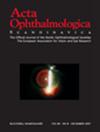Surgical detachment of irido- and lenticulocorneal adhesions in peters anomaly
Abstract
Aims/Purpose: To report anatomical and visual acuity outcome of surgical detachment of iridocorneal or lenticulocorneal adhesions in pediatric patients with Peters anomaly.
Methods: An observational study of pediatric patients with Peters anomaly treated with surgical detachment of iridocorneal or lenticulocorneal adhesions between 2011 and 2024 at the Helsinki University Hospital. Ocular and extraocular diagnoses, age, sex, best corrected visual acuity (BCVA), intraocular pressure, ocular surgeries, surgical complications, family history, genetics and anterior segment optical coherence tomography data were collected from the medical records.
Results: Fourteen eyes from nine patients underwent the surgery. The median age at the time of surgery was 14 months (range 5-56) and the median follow-up period was 156 months (range 6-166). Of the treated eyes, 12 had iridocorneal adhesions, while two eyes also had lenticulocorneal adhesions. No surgical complications were reported. Anterior segment anatomy and corneal clarity were stable or improved during the follow-up. Among the fourteen eyes, three eyes achieved a BCVA better than 0.3 (Snellen decimal), while none had a BCVA worse than 0.05. BCVA was not available for three treated eyes due to the patients' young age. The following additional ocular conditions were recorded: microphthalmia, cataract, glaucoma, retinal degeneration, nystagmus, corectopia and strabismus. Four eyes underwent further ocular surgeries, such as cataract surgery with intraocular lens implantation, anterior vitrectomy, pupilloplasty, and temporal iridectomy. Five patients had systemic findings. Pathogenic variants in the PITX3 and RARB genes were detected in three patients and one patient, respectively.
Conclusions: This study demonstrates that surgical detachment of irido- and even lenticulocorneal adhesions in Peters anomaly is safe and results stable anatomical and visual acuity outcome over the period of critical visual development.

 求助内容:
求助内容: 应助结果提醒方式:
应助结果提醒方式:


